
Foreign women are not available at the Kaifeng Night Market — even if there’s a demand.
“Wow, you have a foreign girl — you’re really sharp!” The almond tea vendors, wearing white coats and kufi — the traditional Muslim caps for men — reveled in the fact that my Chinese husband, John, had a foreign wife. But their revelry was more than just a casual curiosity.
“I’d like a foreign wife,” one of the vendors declared in a rough Henan accent. “How do you get one?”
You don’t get one at the Kaifeng Night Market.
But you will find so much more, from fantastic xiaochi (小吃), which means
snacks), to quirky people (including the aforementioned foreign-babe obsessed vendors) and a uniquely boisterous atmosphere. The Kaifeng Night Market is a living relic, a reminder of the forte volume and flavorful delicacies of night markets that once blanketed the country, but are now disappearing because of city beautification or cleanup projects. (Interestingly, my friend Frank G, who works as a judge in Kaifeng, said that the city cannot shut the market down, because they’re afraid the sellers would protest.) But, most of all, it is relaxing, fun and leaves you with none of the touristy aftertaste associated with China’s major attractions.

Surprisingly, many foreigners come so close to the Kaifeng Night Market, even if they don’t visit it. That’s because Kaifeng, located in Henan Province, sits on the railway line connecting Beijing and Xi’an. They speed right by this beauty of a night market, and town, on to Xi’an. It’s a shame, because they either don’t have the time, or don’t know that they’re missing something so traditionally Chinese, and so delicious.
Night markets, or yeshi (夜市), began in Xi’an in the late Tang Dynasty, bucking the strict rules of market operating hours dictated by the emperor. Night markets spread to Luoyang (also in Henan), Yangzhou (in Jiangsu), and, of course, Kaifeng. By the Northern Song Dynasty, A.D. 965, the emperor Qiande — perhaps realizing the government could no longer stop the trend — cancelled the laws forbidding night markets. In today’s China, while many unofficial night markets still thrive here and there, only a smattering of bustling, official night markets exist, and Kaifeng — with its city wall, lack of tall buildings, and surviving old architecture — is an alluring place to see the night market culture in action.
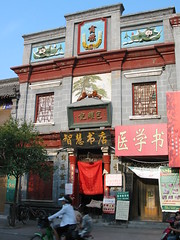
Start your night market visit with a mid-afternoon stroll on Shudian Jie (书店街), the street directly across from Gulou (鼓楼) Plaza where the night market is centered. You’ll feel as if you just wandered into a Qing Dynasty novel, because every building is a stunning, often three-dimensional, work of art rarely seen on a thriving street in China. A Taoist deity with bats and peaches, over a rich peacock border; lotus flower accents and gnarled mountain pines; a young girl clutching a dragon prancing over peonies. You’ll find this, and more, carved into the buildings that line the street.
And, best of all, your eyes will delight as much in the art as in the bustling commerce there. That’s because real businesses inhabit these museum-worthy facades — including some with nice China souvenirs. Don’t forget to find the Xinhua bookstore — it’s probably the only one in China truly worth a photograph.
By 5pm, head back to the plaza for what I like to call the Kaifeng Night Market “pre-show.” Buy yourself a drink at the KFC on the plaza, and then go to the 2nd floor and find a seat next to the window overlooking
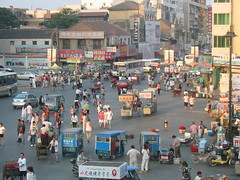
the plaza (not always easy to do in this eternally mobbed fast-food restaurant, but possible with persistence). Then keep your eyes on the street. At first, you’ll only see an impossible mash-up of bicycles, cars, rickshaw taxis, and buses. But, as time passes, a strange, boxy type of traffic will begin trickling into the road. Yes, the night market booths are on parade, if precariously so, and they don’t mind jostling for space, even with the menacing buses. At first, you’ll only see one or two, but then pretty soon it becomes a deluge, as if, Monty Python cartoon style, the sky opens and out comes nothing but night market booths. You’ll also find trucks loaded with folding chairs in the mixture, which, along with the booths, begin to fill up the

once-empty night market plaza. The pre-show gets your appetite ready for the real thing. And, if you can read Chinese, you’ll be able to locate your favorite xiaochi vendors, once things are set up and running — usually by 6:30pm.
Step outside into the carnival atmosphere, as the night market — with its light-up signs on booths, strings of lanterns, troubadour musicians playing Chinese songs, and street actors — begins. Breathe in the atmosphere as you wander around the
market, which spills out into Gulou Jie and even Shudian Jie, with your eyes as the perfect guide. Just keep in mind a few ground rules. Eat only fully cooked foods (which, thankfully, includes most of what’s available in the night market). Never let vendors change large bills — 50 RMB or more —

for you (unscrupulous vendors may slip you counterfeit notes, which has happened to me, and many vendors simply haven’t the ability to change large bills, leaving you stuck with an empty stomach). Go where the crowds go, because they usually know the best, and most hygienic, vendors.
Don’t miss the Kaifeng specialties, such as Kaifeng-style dumplings or
xiaolongbao (小笼包), Henan-style la mian (拉面), fried bean-starch noodles or chao liangfen (炒凉粉), and peanut cakes or huashenggao (花生糕). Kaifeng people also love fried bean starch chunks or chao liangpi (炒凉皮), meat “sandwiches” called roujiamo (肉夹馍), oven-baked flatbread (used in the roujiamo) called baijimo (白吉馍), pepper hot soup
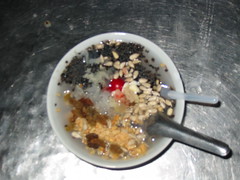
or hu la tang (胡辣汤), mutton skewers or yangrou chuan (羊肉串)and vegetable skewers or sucai chuan (素菜串), and, one of my favorites, the sweet, dessert-like almond tea or xingrencha (杏仁茶). Fortunately, even if you don’t know Chinese, you can point and choose your way to a delicious meal.
Seating can be tight, but this is xiaochi, which gets eaten fast — so even if you can’t find something immediately, wait a few minutes and spaces appear. Chances are, you’ll sit down, nearly elbow-to-elbow with a Chinese, and hungrily devour your xiaochi of choice accompanied by a boisterous hum of what the Chinese call renao (热闹, or “hot and loud”) atmosphere. Leave those earplugs at home, because this is half the fun.
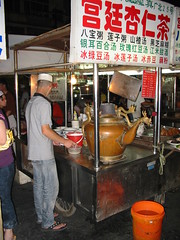
Even after you’ve had your fill of xiaochi, enjoy a little booth and people watching as a special after-dinner aperitif. You’ll delight in the troubadour musicians strumming old Chinese ballads, street actors entertaining crowds on Shudian Jie, and the gorgeous, Aladdin-like “magic teapots” used for pouring the almond tea, or xingrencha.
But, you won’t find foreign women on display — unless, that is, you caught a glimpse of me winding my way through the market.
Happy travels.
—–
When to visit
As an outdoor attraction, Kaifeng’s Night Market is best visited in the Spring, Summer or Autumn. Since Kaifeng is on the dry loess plains, don’t expect much rain, but Spring and Autumn can bring the occasional dust storm. If coming in the Summer, be sure to arm yourself with a good sun parasol (available in UV-protective versions in Chinese supermarkets).
Getting there
By Plane: Your best bet is Xinzheng Airport in Zhengzhou, just an hour out of Kaifeng. You can either take a taxi ( ~100 RMB), or take the airport bus (every hour, on the hour, 15 RMB) to Jinshui Road (金水路 — also the first stop for the bus). Whether you take the bus or taxi, make sure you get to the Deyi Bus Station on Jinshui Road (德亿汽车站) — they have frequent (and comfortable) buses to Kaifeng from 6am to 10:30pm, fare is 7 RMB per person and the trip takes 75 minutes.
By Train: There are frequent trains between Zhengzhou and Kaifeng, but less so from major cities (such as Beijing or Xi’an) to Kaifeng — and the trains that do go from major cities can be slow. If you can’t get a direct train to Kaifeng, no worries — go into Zhengzhou first. You then have the option of buying a train ticket to Kaifeng, or going to the Deyi Bus Station mentioned above (which may be more comfortable, without the hassle of buying train tickets).
Where to stay
There are nice budget options in Kaifeng or Zhengzhou. If you want to stay late at the night market, and want something more quaint, go for Kaifeng. One possibility is the Kaifeng Guest House, located in the center of the city (rooms 175 RMB or less).
If Zhengzhou is your base to explore other places, consider the dated, but enormously hospitable and helpful Wuhua Hotel on Weiwu Road (rooms ~ 172 RMB, more or less). Their sumptuous breakfast buffet alone is worth it.
Find these and more by booking — online, as I did — at Ctrip.com (no deposit needed, and you can cancel easily, if necessary).
—–
This is the first article in the Travel China with the Yangxifu series, which will appear every 2nd Wednesday of the month. Thanks to Rich for inspiring me to launch this series — this one’s dedicated to you! 😉
To read more, visit the Travel China with the Yangxifu archives.
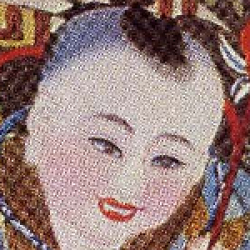
Jocelyn, what a wonderful Post. You have a real love for Chinese Ways, and it shows. The PRC has so much “goin’ on”, and , as you mention, many of us just fly-by on express trains, without a clue what we missed. Thank You. RichFromTampa
Hi Rich,
Thanks for the comment! Glad I could enlighten you about a lovely little corner of the PRC — it’s amazing what’s out there, and I know there’s plenty I have yet to discover myself. 😉
I live in Zhengzhou and I’m ready to go back to Kaifeng after this post. Great details. It’s been about three years since I visited. Are you familiar with the Number 4 hospital (old well) and the Kaifeng Jews? Pam in Henan
Pam, please don’t tease… what is the story of the Kaifeng Jews?? RichFromTampa
Thanks so much for the comment Pam! Yes, I have heard of the Number 4 hospital, though this time around I didn’t get to visit it. Pam is referring to the remains of a synagogue in this hospital in Kaifeng. Kaifeng is the home of one of China’s oldest Jewish settlements (the Jews came there via the Silk Road). There are descendants of the Jews still there, though from what I know, they don’t practice, and, obviously, the synagogue is no longer in use.
Pam, feel free to add something I’m missing.
BTW, Pam, I visited your website, and it’s a very touching organization. I’m grateful to know you’re doing such life-changing work in Zhengzhou, my old stomping grounds.
xiaolongbao (çŒæ±¤å°ç¬¼åŒ…), baijimo (白å‰é¦), pepper hot soup or hu la tang (湖辣汤)…..these make me completely homesick….. 🙂
Dear VicSion,
Aw, thanks for the sweet comment!
While I can’t claim they make me homesick, I will say they certainly make me hungry (and long to get back to China to taste some fine xiaochi (å°åƒ) soon!
Hi I loved reading this! I am about to move to Kaifeng in Feb. and was wondering if you have any advice. Thanks!
Hi Nicholas, thanks for the comment! Anything specific you were looking for advice on? That would help me more easily respond to you.